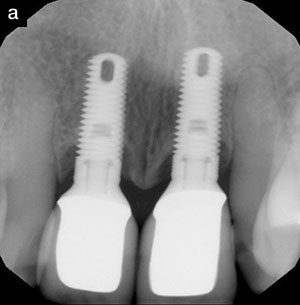INTRODUCTION
One of the most creative advancements in aesthetic dentistry throughout the last decade has been digital smile design.1 As part of the process, valid measurements are essential to the procedure. In addition, continuous measurements are necessary during all of the clinical and laboratory procedures. Since the foundation of aesthetic success begins with the premise that sound restorations must be supported by adequate bone, the first measurements need to begin while doing the periodontal assessment.
We all use a multitude of different diagnostic and restorative instruments in our daily lives as restorative dentists. Thankfully, any new instrument that promises to simultaneously save time and promote efficiency is a welcome addition to our dental armamentarium. One such instrument that has been a help in our practice will be showcased in this article.
There are several important factors that are taken into consideration when diagnosing periodontal disease. One of the most common and reliable methods in diagnosing sulcular depth is by using a periodontal probe. Although periodontal probing is mandatory for accurate diagnosis and baseline assessment, it is often met with challenges and resistance from both clinicians and patients. Because of past discomfort, patients can be both hesitant and nervous about probing and too often decline necessary periodontal probing and hygiene treatment recommendations. In turn, clinical/clinician challenges that may include time shortage, patient discomfort, and poor visibility can lead to reduced probing or no probing at all. Fortunately, one recent advancement in this area is a new probe that is more comfortable for patients and makes it much easier to visualize the actual numbers when using it.2
New Periodontal Probe Recently Introduced
The new Colorvue Goldstein Probe (Hu-Friedy), which was developed in partnership with world-renowned clinician Dr. Ronald Goldstein, differs from the typical metal probe, as it has been designed for greater accuracy for periodontal measuring and especially for use in restorative dentistry (Figure 1). This uniquely designed probe uses bright colors to differentiate measurements in 0.5-mm increments from 0.5 mm up to 3.0 mm (ie, 0.5, 1.0, 1.5, 2.0, 2.5, and 3.0 mm) and then in 1.0-mm increments up to 13.0 mm (Figure 2). The Colorvue Goldstein Probe is not only designed to be used for a more accurate pocket depth reading (Figure 3), it is also a great diagnostic tool in instant measurement of gingival recession and assistance in margin placement (Figure 4). It can also be helpful in quick orthodontic evaluations and for instant measurement of overbites and overjets (Figure 5).
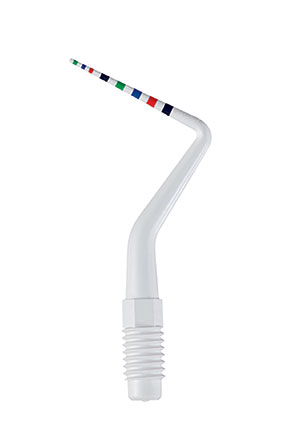 |
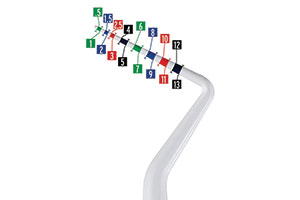 |
| Figure 1. The bright colors of the Colorvue Goldstein Probe (Hu-Friedy) make for easier and quicker number visualization as compared to the typical metal probe. Note the gentle curve at the end and the taper that patients find more comfortable than the typical metal probe. | Figure 2. The Colorvue Goldstein Probe’s first series of measurements in 0.5-mm increments (up to 3.0 mm) are useful in the precise probing of sulcular depth for both periodontal and restorative dentistry. |
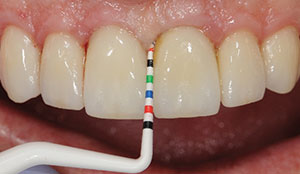 |
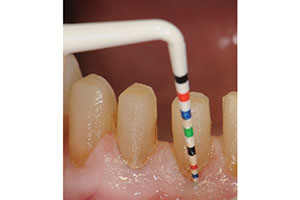 |
| Figure 3. Using bright colors clearly aids in probe-measuring a pocket depth of 3.0 mm of this central incisor. | Figure 4. Sulcular depth measurement is extremely important during margin placement. |
An Essential Tool for Accurate Treatment Planning
As dental professionals, we long for predictable, ideal, and reproducible ways to achieve success in aesthetics and smile design. We often go by the Golden Proportion, which at times can be pleasing, but at other times may not be applicable to a portion of our patient population.3 In smile design and achieving the best aesthetic outcome, individual tooth size and proportion are the only certain factors.4,5 The Colorvue Goldstein Probe can be an essential tool in your practice during diagnosis and treatment planning, in direct and indirect tooth bonding, and in indirect restoration preparation procedures.
Determining Correct Sulcular Depth
Another use of the Colorvue Goldstein Probe is to measure the sulcular depth that is essential in subgingival margin placement. Quite often (due to root sensitivity, caries, existing restoration, or aesthetics), margin placement is extended into the gingival sulcus. The common consensus among research studies, leading experts, and authors indicate that an average of 3.0 mm of biologic width is ideal.6,7 A great rule to follow, by Grieder and Cinotti,8 states that the margin should be placed midway between the apical and coronal borders of the sulcus. Optimal and long-lasting post-restorative gingival health and success are highly correlated to this step-in margin placement procedure. The Colorvue Goldstein Probe’s 0.5-mm increments (up to 3.0 mm) helps clinicians arrive at a predictable subgingival margin. The bright colors of the probe make it easier to differentiate between these measurements and make the probing process much quicker and more accurate.
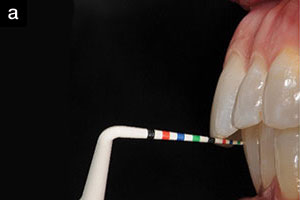 |
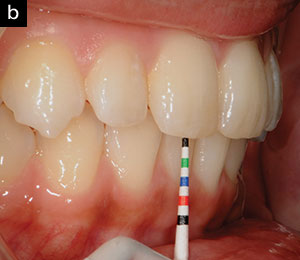 |
| Figure 5a. During a first consultation appointment, an exact measurement of overjet was found to be 4.0 mm for this patient. | Figure 5b. An overbite measurement of 4.0 mm was quickly seen during orthodontic evaluation. |
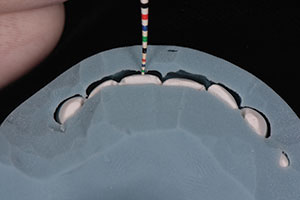 |
| Figure 6. A silicone putty matrix (Sil-Tech [Ivoclar Vivadent]) made from a diagnostic wax-up was used on a preoperative study model to help measure the amount of thickness needed to build out the restorations to an ideal smile. |
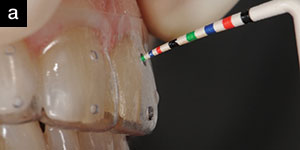 |
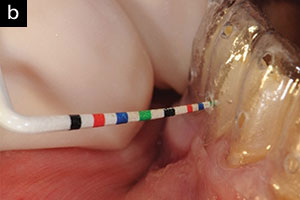 |
| Figure 7. Use of a Colorvue Goldstein Probe with holes made into the vacuform matrix made from the diagnostic wax-up can visibly help assess and verify the amount of reduction needed during preparation phase. |
Measuring Optimal and Conservative Preparation Reduction
To ensure higher success with adhesive restorative procedures, we know that bond strength is much stronger with enamel than dentin; therefore, conserving as much healthy enamel tooth structure as possible should be a high-priority objective for the clinician. We often ask ourselves, “Do I have enough space required for this restoration?” The amount of tooth structure removed should be determined by the diagnostic wax-up. The information provided by the silicone putty (or vacuform matrix) made from the diagnostic wax-up can help assess the proper amount of tooth reduction needed, especially in cases where minimal reduction is needed for porcelain veneers (Figure 6). Two small holes are drilled into the labio-incisal and labio-gingival parts of each of the teeth to be prepared on the vacuform matrix (Figure 7).
Another great use of the Colorvue Goldstein Probe is during a crown preparation to predict for ideal labial, occlusal, and lingual reduction using a preformed vacuform matrix with the holes prepared (Figure 8). The Colorvue Goldstein Probe can serve as a useful tool in measuring ideal and conservative reduction during preparation of porcelain veneers.
Although the conservative nature of prepless veneers is popular and more appealing to patients, the idea of no preparation is often not practical, as some degree of preparation may be needed to achieve an optimal aesthetic outcome.
The following case (Figures 8 to 13) will demonstrate the benefits of minimal preparation using predictable measurements.
CASE REPORT
A 70-year-old patient presented with discolored teeth and a lack of lip support, desiring a fuller and brighter smile (Figure 8). A clinical examination revealed discolored and worn teeth with the presence of vertical microcracks and a loss of the interdental papillae. There was also a missing congenital lateral, creating an uneven space problem.
Porcelain veneers were recommended and explained as a potential treatment, pending analysis of the diagnostic study models and wax-up (Figure 9).
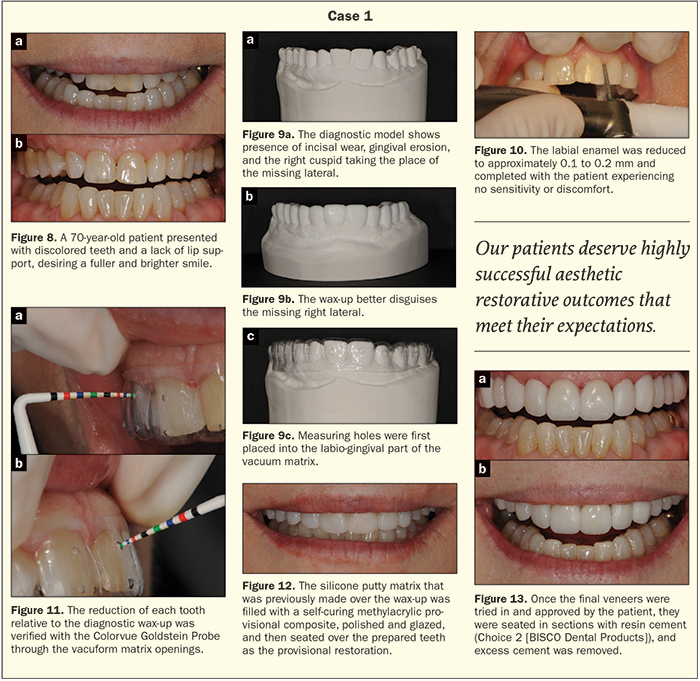 |
Clinical Protocol
The labial enamel was reduced to approximately 0.1 to 0.2 mm with the patient experiencing no sensitivity or discomfort (Figure 10). All areas of the teeth were prepared and measured to ensure adequate thickness of the all-ceramic veneers. The reduction of each tooth relative to the diagnostic wax-up was verified with the Colorvue Goldstein Probe through the vacuform matrix openings (Figure 11).
The silicone putty matrix (Sil-Tech [Ivoclar Vivadent]) (previously fabricated using the diagnostic wax-up) was filled with a self-curing methylacrylic provisional composite (Luxatemp Fluorescence [DMG America]) and seated over the teeth. The final provisional was polished and glazed (Figure 12), and the patient was released.
Once the final all-ceramic veneers (IPS e.max [Ivoclar Vivadent]) were received from the dental lab team, they were tried-in and approved by the patient at the delivery appointment. The restorations were adhesively bonded into place (simultaneously) using a resin cement system (Choice 2 [BISCO Dental Products]) (Figure 13).
CLOSING COMMENTS
Our patients deserve highly successful aesthetic restorative outcomes that meet their expectations. Whenever possible, this should ideally be done using a minimally invasive approach to care. Accuracy, predictability, control, comfort, safety, and visibility are all essential parts of delivering the best care possible to your patients. As described in this article, the Colorvue Goldstein Probe can play a variety of important roles (diagnostic, periodontal, and restorative) in the everyday practice.
References
- Coachman C, Calamita M. Digital smile design: a tool for treatment planning and communication in esthetic dentistry. Quintessence Dent Technol. 2012;35:103-111.
- White YA, Robinette CK, Bahry A. Probe selection: a hygiene team’s review of periodontal probes considers several factors. RDH. 2016;36:62-63.
- Preston JD. The golden proportion revisited. J Esthet Dent. 1993;5:247-251.
- Sterrett JD, Oliver T, Robinson F, et al. Width/length ratios of normal clinical crowns of the maxillary anterior dentition in man. J Clin Periodontol. 1999;26:153-157.
- Ali Fayyad M, Jamani KD, Aqrabawi J. Geometric and mathematical proportions and their relations to maxillary anterior teeth. J Contemp Dent Pract. 2006;7:62-70.
- Tarnow DP, Magner AW, Fletcher P. The effect of the distance from the contact point to the crest of bone on the presence or absence of the interproximal dental papilla. J Periodontol. 1992;63:995-996.
- Tarnow D, Stahl SS, Magner A, et al. Human gingival attachment responses to subgingival crown placement. Marginal remodeling. J Clin Periodontol. 1986;13:563-569.
- Grieder A, Cinotti WR. Periodontal Prosthesis. St. Louis, MO: Mosby; 1968.
Dr. Esfandiari graduated from Georgia State University in 2007 and received her Doctor of Dental Medicine degree from the Dental College of Georgia in 2011, where she received the prestigious Goldstein Esthetic Award in her last year. Following graduation, she accepted a post-doctorate aesthetic Fellowship with Dr. Ronald Goldstein in Atlanta. Dr. Esfandiari worked closely with Dr. Goldstein on many large full-mouth rehab and cosmetic cases. As part of her training on the weekends, she also did research and assisted Dr. Goldstein on the 3rd edition of his book, Esthetics in Dentistry. Upon completion of her aesthetics fellowship, she was offered a full-time position as an associate dentist at Goldstein, Garber, & Salama in 2011. She can be reached via the email address at nadiadmd@yahoo.com.
Disclosure: Dr. Esfandiari reports no disclosures.
Related Articles
Squid Ink Enables More Accurate Pocket Measurements
Surgical Navigation Improves Planning and Precision







